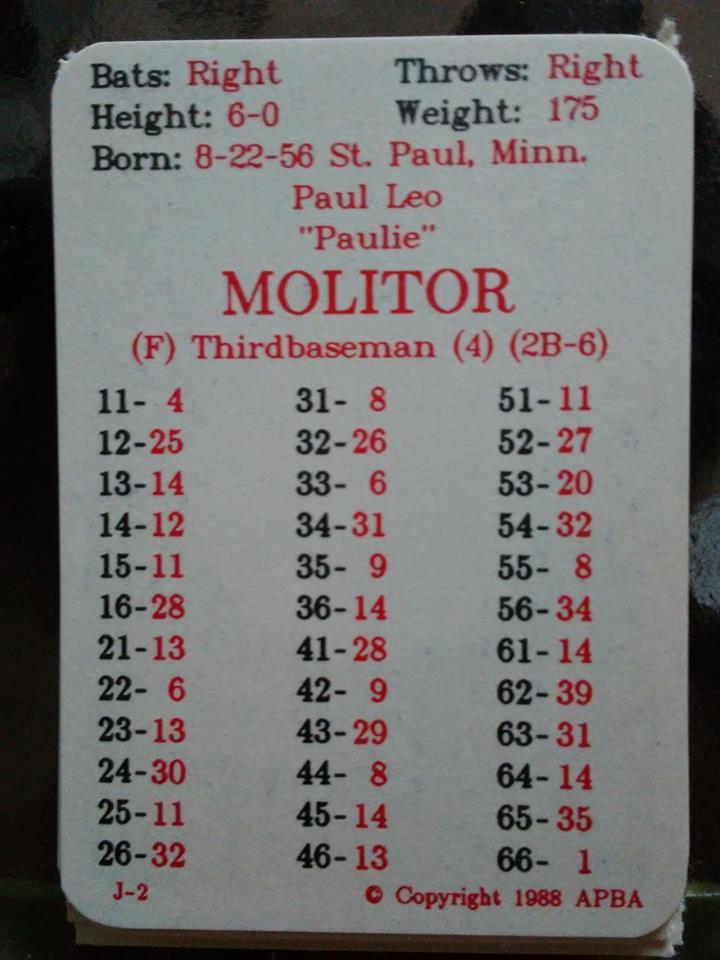
This submission comes from a Facebook post by Wisconsin Tournament organizer Kurt Bergland who is selling some of his APBA collection. The 1987 Milwaukee Brewers are on his selling list and of course, Paul Molitor is a top player on that team.
Despite playing just 118 games, “Paulie” led the AL with 114 runs and 41 doubles. He batted a nifty .353 for the Brewers while hitting 16 homers. His 69 walks contrasted with his 67 strikeouts.
Molitor was primarily a DH in 1987 but appeared as a third baseman in 41 games and as a second baseman in 19.
| Split | G | PA | AB | R | H | 2B | 3B | HR | RBI | SB | BB | SO | BA | OBP | SLG |
|---|---|---|---|---|---|---|---|---|---|---|---|---|---|---|---|
| 1987 Totals | 118 | 542 | 465 | 114 | 164 | 41 | 5 | 16 | 75 | 45 | 69 | 67 | .353 | .438 | .566 |
Despite his prevalence as a DH in 1987, APBA rated him as a 3B-4. It’s probably warranted as Molitor was a gifted and skilled defender in previous years.
But his hitting! He was rewarded with plenty of hit numbers thanks to his .353 batting average. His 41 doubles helped him get power numbers 1-4-6-6 while his 45 stolen bases gave him three full 11s (that’s a 51-11!). That equals a 42-9, folks.
What really tops this card off is Molitor’s five 14s. Paulie has twelve on-base chances against an Grade A Pitcher which in my book, is pretty good.
What struck me about Molitor’s 1987 card is that it has a 21-13 but overall, only has three 13s. Between the hit numbers and 14s, there were just not as many places to put them (APBA was more rigid about placement of the 13 back then).
It’s worth mentioning that 1987 Molitor is Fast, has no 24s and plays second base as his secondary position.
In my research, I found out that Molitor went to the University of Minnesota and played for the Golden Gophers. That puts his managerial position with the Twins in context.
Thanks and good luck, Kurt!




I remember that card well. In early 1987 I swapped an aging Bobby Grich + a 2nd round pick for The Ignitor, then spent the summer watching his career year unfold. The card’s stats for my LDBA team closely mimicked his real-life numbers: 118 G, 557 PA, 480 AB, 115 R, 175 H, 46 2B, 10 3B, 15 HR, 76 RBI, 61 SB, 71 BB, 68 K, .365* BA, .445* OBP, .596 SLG. *38-year franchise records. Paulie went on to play a dozen seasons for the Bruins, hitting .306/.374/.459 with 139 HR and 411 SB.
P.S. Molitor’s 1987 secondary position was 2B, not SS. His final appearance at SS was in 1982.
Hi Bruinskip,
Doh! I fixed the error. Thanks!
Thanks also for sharing your numbers. He really did come close to simulating his actual stats!
How many teams were in LDBA? I’m just curious how concentrated the pitching talent was in the league. Our IAL is pretty rich in pitching because we’re a 10-team league. As a result, individual batting averages are way down.
Tom
Depending on who the second round pick this might qualify as the greatest trade in the history of your league.
Don’t recall who pick #34 was that year, but Grich did hit .293 in his final LDBA season compared to .271 for Molitor. Rookies that debuted with Paulie’s former team that year included Eric King,, Kevin Seitzer, Ruben Sierra, Dale Sveum, and Dave Valle, so there’s a good chance the drafted player wasn’t worthless.
More than a thousand trades have been made in 38 LDBA seasons; I’m sure a fair number were even more lopsided. One of my personal favorites dates back to our inaugural season in 1981, when I swapped Mike Sadek for Rod Carew. At the other end of the spectrum, I traded away Jose Bautista in 2008 for a 2nd round pick wasted on Travis Buck. The guy I was dealing with wanted Greg Dobbs but I convinced him to take Bautista instead. Whoops.
Bruinskip,
Sadek for Carew, wow!
While we’re throwing out lopsided deals, here’s mine…
I received a young Tom Glavine as a throw-in as part of an aging Kirk Gibson-Melido Perez deal. I never traded him and eighteen years later he was inducted as a IAL Hall of Famer.
To be fair, Glavine was a DW at the time and just an unproven prospect.
Tom
WOW! Supercard.
I really enjoy seeing what you share here.
Back then the LDBA was an 18-team league (compared to 26 in MLB). In 2000 the LDBA expanded to 20 teams.
That makes sense. A little more realistic, in my opinion.
Get those D pitchers in there!! :)